EDF5017: Numeracy for Learners and Teachers - Assessment Task 2 Report
VerifiedAdded on 2023/03/29
|19
|2808
|463
Report
AI Summary
This document presents a comprehensive solution to Assessment Task 2 for the EDF5017 Numeracy for Learners and Teachers course. The assignment is divided into two parts: a lesson plan and a NAPLAN data analysis. The lesson plan, designed for Year 3 students, focuses on the topic of the population of Australia and integrates elements of the Humanities and Social Sciences curriculum. It outlines lesson aims, mathematical skills, and understandings, referencing the ACARA curriculum. The lesson overview details the activities, student and teacher roles, and time allocation. The second part of the assignment involves an analysis of NAPLAN numeracy data for School X, comparing its performance with similar schools and all Australian schools across Year 3 and Year 5. The analysis examines mean scores, student achievement by band, and the progression of students over time, providing insights into the school's performance and areas for improvement. The report also links the lesson plan to the 21st Century Numeracy Model, highlighting the application of statistical tools and spatial reasoning.
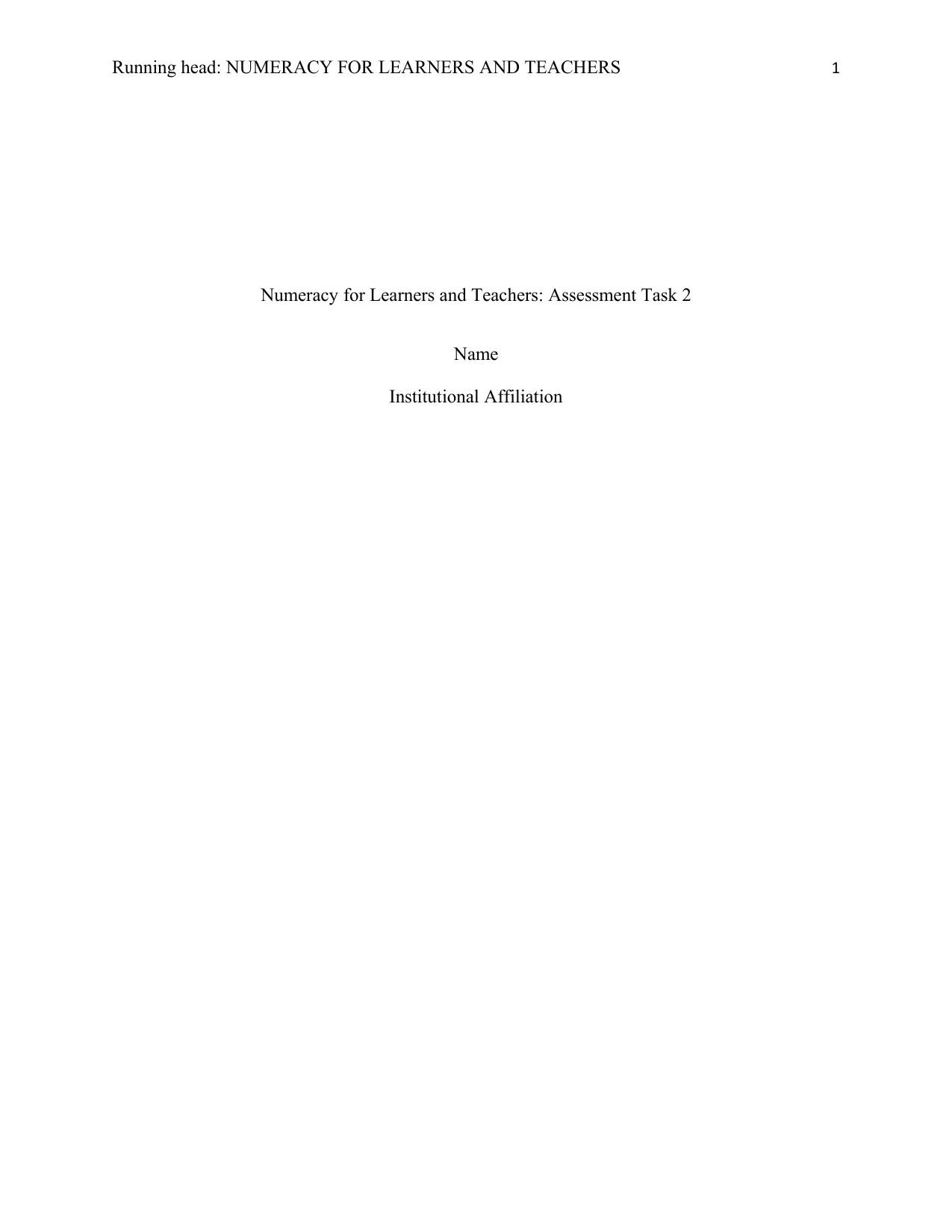
Running head: NUMERACY FOR LEARNERS AND TEACHERS 1
Numeracy for Learners and Teachers: Assessment Task 2
Name
Institutional Affiliation
Numeracy for Learners and Teachers: Assessment Task 2
Name
Institutional Affiliation
Paraphrase This Document
Need a fresh take? Get an instant paraphrase of this document with our AI Paraphraser
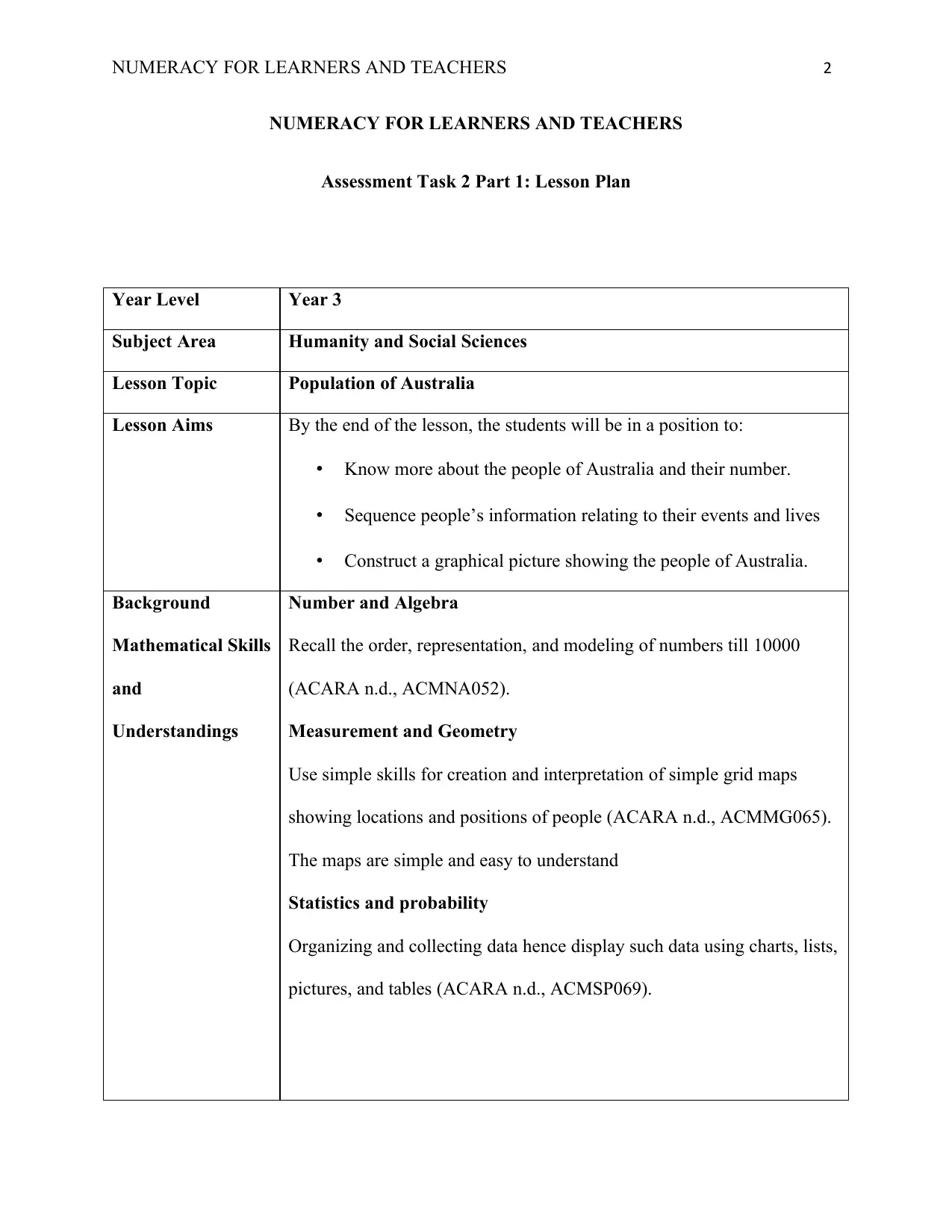
NUMERACY FOR LEARNERS AND TEACHERS 2
NUMERACY FOR LEARNERS AND TEACHERS
Assessment Task 2 Part 1: Lesson Plan
Year Level Year 3
Subject Area Humanity and Social Sciences
Lesson Topic Population of Australia
Lesson Aims By the end of the lesson, the students will be in a position to:
• Know more about the people of Australia and their number.
• Sequence people’s information relating to their events and lives
• Construct a graphical picture showing the people of Australia.
Background
Mathematical Skills
and
Understandings
Number and Algebra
Recall the order, representation, and modeling of numbers till 10000
(ACARA n.d., ACMNA052).
Measurement and Geometry
Use simple skills for creation and interpretation of simple grid maps
showing locations and positions of people (ACARA n.d., ACMMG065).
The maps are simple and easy to understand
Statistics and probability
Organizing and collecting data hence display such data using charts, lists,
pictures, and tables (ACARA n.d., ACMSP069).
NUMERACY FOR LEARNERS AND TEACHERS
Assessment Task 2 Part 1: Lesson Plan
Year Level Year 3
Subject Area Humanity and Social Sciences
Lesson Topic Population of Australia
Lesson Aims By the end of the lesson, the students will be in a position to:
• Know more about the people of Australia and their number.
• Sequence people’s information relating to their events and lives
• Construct a graphical picture showing the people of Australia.
Background
Mathematical Skills
and
Understandings
Number and Algebra
Recall the order, representation, and modeling of numbers till 10000
(ACARA n.d., ACMNA052).
Measurement and Geometry
Use simple skills for creation and interpretation of simple grid maps
showing locations and positions of people (ACARA n.d., ACMMG065).
The maps are simple and easy to understand
Statistics and probability
Organizing and collecting data hence display such data using charts, lists,
pictures, and tables (ACARA n.d., ACMSP069).
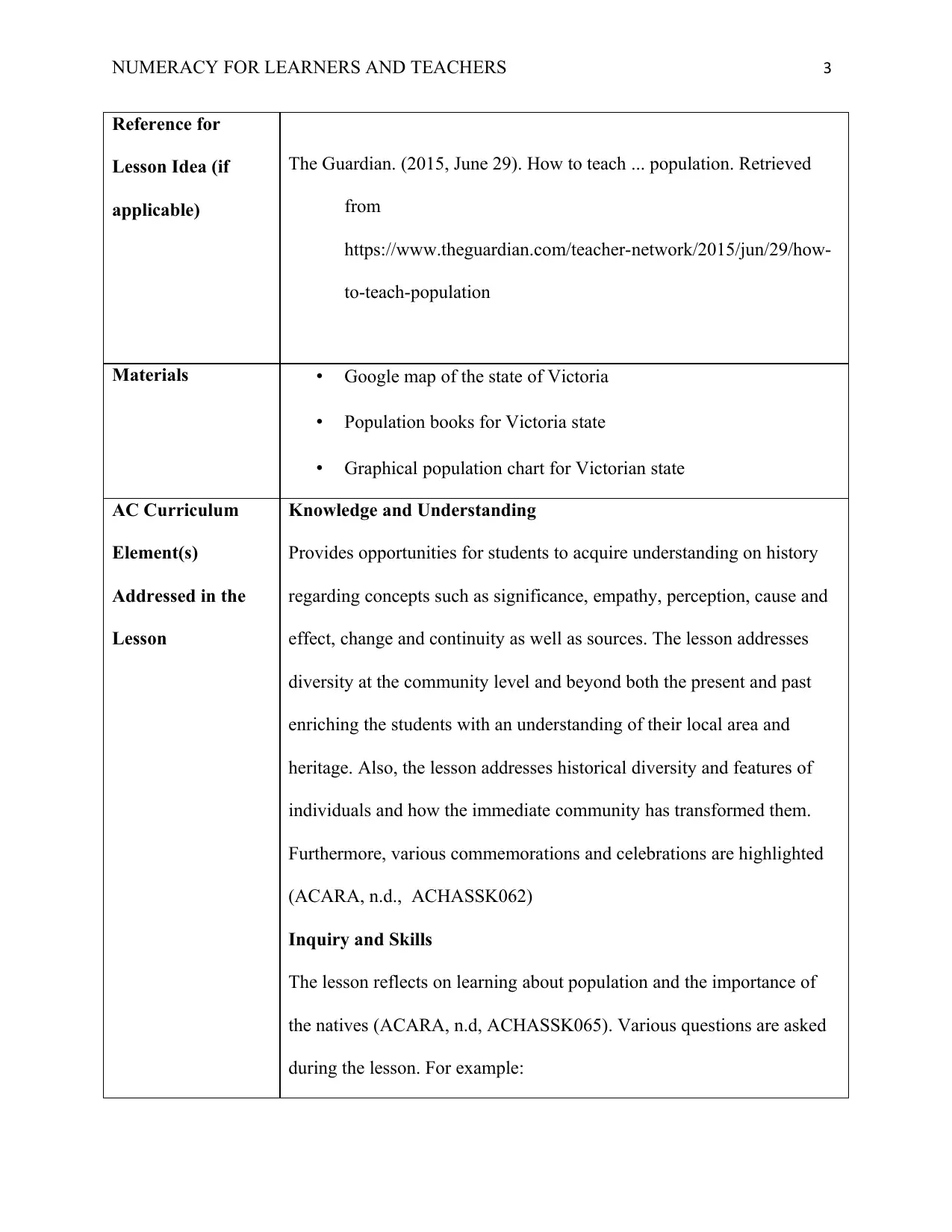
NUMERACY FOR LEARNERS AND TEACHERS 3
Reference for
Lesson Idea (if
applicable)
The Guardian. (2015, June 29). How to teach ... population. Retrieved
from
https://www.theguardian.com/teacher-network/2015/jun/29/how-
to-teach-population
Materials • Google map of the state of Victoria
• Population books for Victoria state
• Graphical population chart for Victorian state
AC Curriculum
Element(s)
Addressed in the
Lesson
Knowledge and Understanding
Provides opportunities for students to acquire understanding on history
regarding concepts such as significance, empathy, perception, cause and
effect, change and continuity as well as sources. The lesson addresses
diversity at the community level and beyond both the present and past
enriching the students with an understanding of their local area and
heritage. Also, the lesson addresses historical diversity and features of
individuals and how the immediate community has transformed them.
Furthermore, various commemorations and celebrations are highlighted
(ACARA, n.d., ACHASSK062)
Inquiry and Skills
The lesson reflects on learning about population and the importance of
the natives (ACARA, n.d, ACHASSK065). Various questions are asked
during the lesson. For example:
Reference for
Lesson Idea (if
applicable)
The Guardian. (2015, June 29). How to teach ... population. Retrieved
from
https://www.theguardian.com/teacher-network/2015/jun/29/how-
to-teach-population
Materials • Google map of the state of Victoria
• Population books for Victoria state
• Graphical population chart for Victorian state
AC Curriculum
Element(s)
Addressed in the
Lesson
Knowledge and Understanding
Provides opportunities for students to acquire understanding on history
regarding concepts such as significance, empathy, perception, cause and
effect, change and continuity as well as sources. The lesson addresses
diversity at the community level and beyond both the present and past
enriching the students with an understanding of their local area and
heritage. Also, the lesson addresses historical diversity and features of
individuals and how the immediate community has transformed them.
Furthermore, various commemorations and celebrations are highlighted
(ACARA, n.d., ACHASSK062)
Inquiry and Skills
The lesson reflects on learning about population and the importance of
the natives (ACARA, n.d, ACHASSK065). Various questions are asked
during the lesson. For example:
⊘ This is a preview!⊘
Do you want full access?
Subscribe today to unlock all pages.

Trusted by 1+ million students worldwide
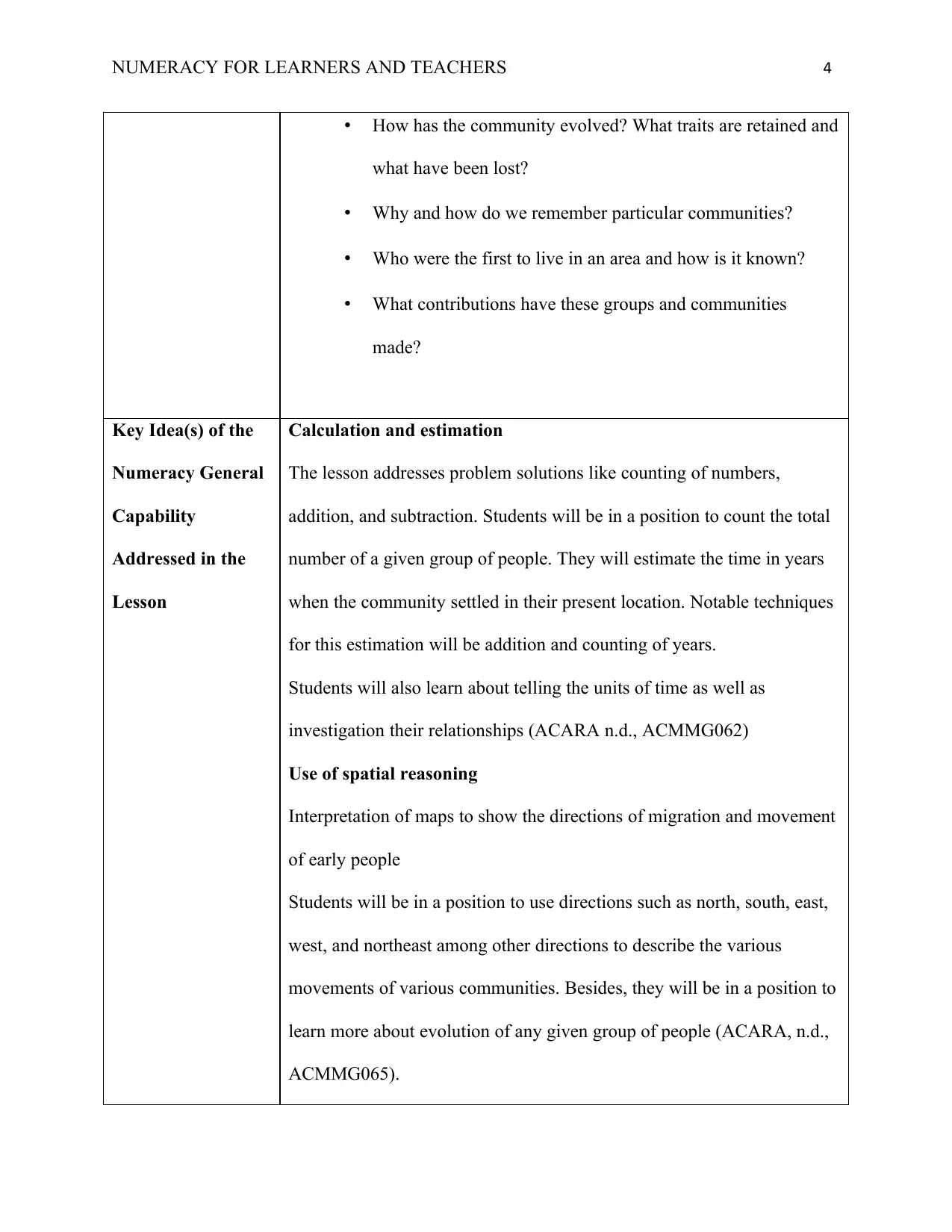
NUMERACY FOR LEARNERS AND TEACHERS 4
• How has the community evolved? What traits are retained and
what have been lost?
• Why and how do we remember particular communities?
• Who were the first to live in an area and how is it known?
• What contributions have these groups and communities
made?
Key Idea(s) of the
Numeracy General
Capability
Addressed in the
Lesson
Calculation and estimation
The lesson addresses problem solutions like counting of numbers,
addition, and subtraction. Students will be in a position to count the total
number of a given group of people. They will estimate the time in years
when the community settled in their present location. Notable techniques
for this estimation will be addition and counting of years.
Students will also learn about telling the units of time as well as
investigation their relationships (ACARA n.d., ACMMG062)
Use of spatial reasoning
Interpretation of maps to show the directions of migration and movement
of early people
Students will be in a position to use directions such as north, south, east,
west, and northeast among other directions to describe the various
movements of various communities. Besides, they will be in a position to
learn more about evolution of any given group of people (ACARA, n.d.,
ACMMG065).
• How has the community evolved? What traits are retained and
what have been lost?
• Why and how do we remember particular communities?
• Who were the first to live in an area and how is it known?
• What contributions have these groups and communities
made?
Key Idea(s) of the
Numeracy General
Capability
Addressed in the
Lesson
Calculation and estimation
The lesson addresses problem solutions like counting of numbers,
addition, and subtraction. Students will be in a position to count the total
number of a given group of people. They will estimate the time in years
when the community settled in their present location. Notable techniques
for this estimation will be addition and counting of years.
Students will also learn about telling the units of time as well as
investigation their relationships (ACARA n.d., ACMMG062)
Use of spatial reasoning
Interpretation of maps to show the directions of migration and movement
of early people
Students will be in a position to use directions such as north, south, east,
west, and northeast among other directions to describe the various
movements of various communities. Besides, they will be in a position to
learn more about evolution of any given group of people (ACARA, n.d.,
ACMMG065).
Paraphrase This Document
Need a fresh take? Get an instant paraphrase of this document with our AI Paraphraser
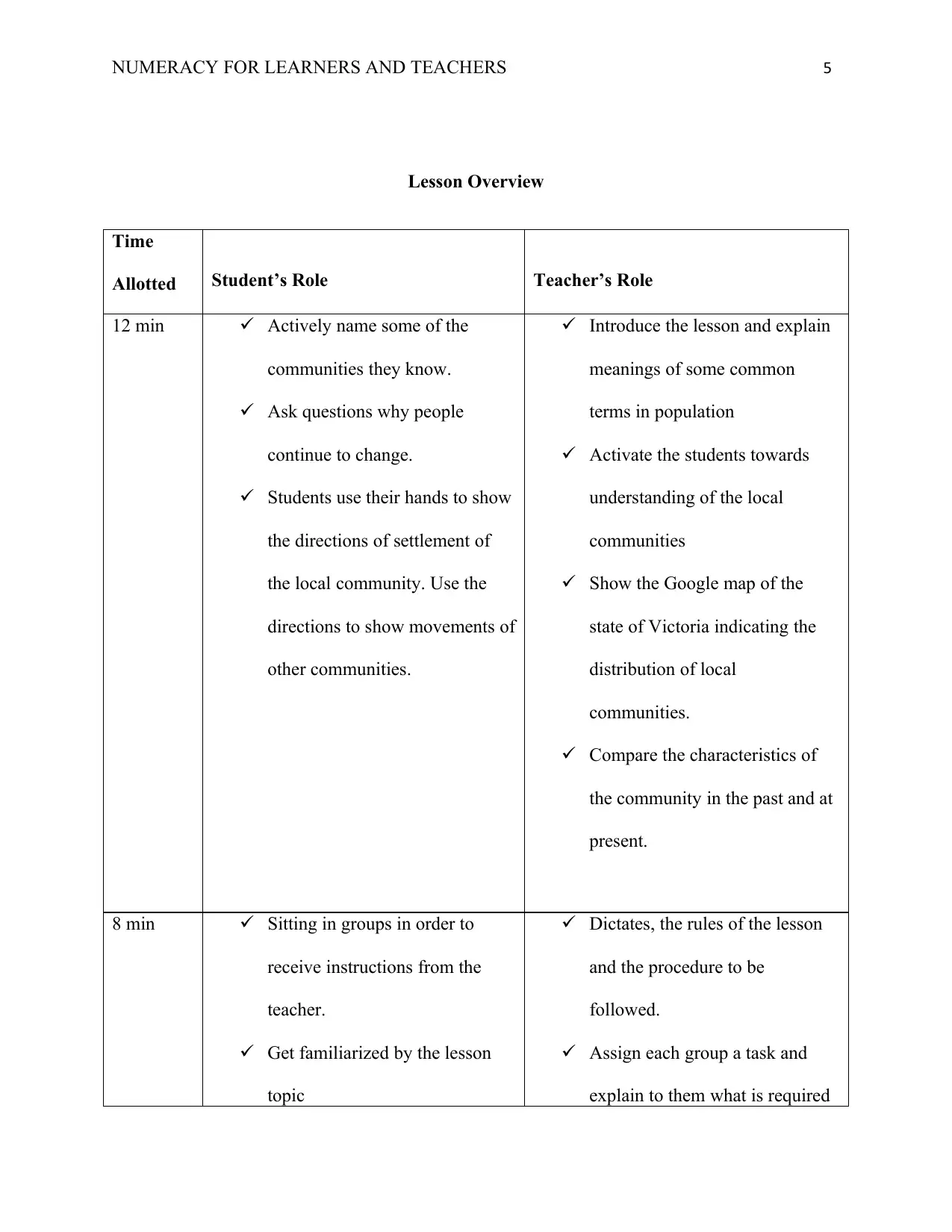
NUMERACY FOR LEARNERS AND TEACHERS 5
Lesson Overview
Time
Allotted Student’s Role Teacher’s Role
12 min Actively name some of the
communities they know.
Ask questions why people
continue to change.
Students use their hands to show
the directions of settlement of
the local community. Use the
directions to show movements of
other communities.
Introduce the lesson and explain
meanings of some common
terms in population
Activate the students towards
understanding of the local
communities
Show the Google map of the
state of Victoria indicating the
distribution of local
communities.
Compare the characteristics of
the community in the past and at
present.
8 min Sitting in groups in order to
receive instructions from the
teacher.
Get familiarized by the lesson
topic
Dictates, the rules of the lesson
and the procedure to be
followed.
Assign each group a task and
explain to them what is required
Lesson Overview
Time
Allotted Student’s Role Teacher’s Role
12 min Actively name some of the
communities they know.
Ask questions why people
continue to change.
Students use their hands to show
the directions of settlement of
the local community. Use the
directions to show movements of
other communities.
Introduce the lesson and explain
meanings of some common
terms in population
Activate the students towards
understanding of the local
communities
Show the Google map of the
state of Victoria indicating the
distribution of local
communities.
Compare the characteristics of
the community in the past and at
present.
8 min Sitting in groups in order to
receive instructions from the
teacher.
Get familiarized by the lesson
topic
Dictates, the rules of the lesson
and the procedure to be
followed.
Assign each group a task and
explain to them what is required
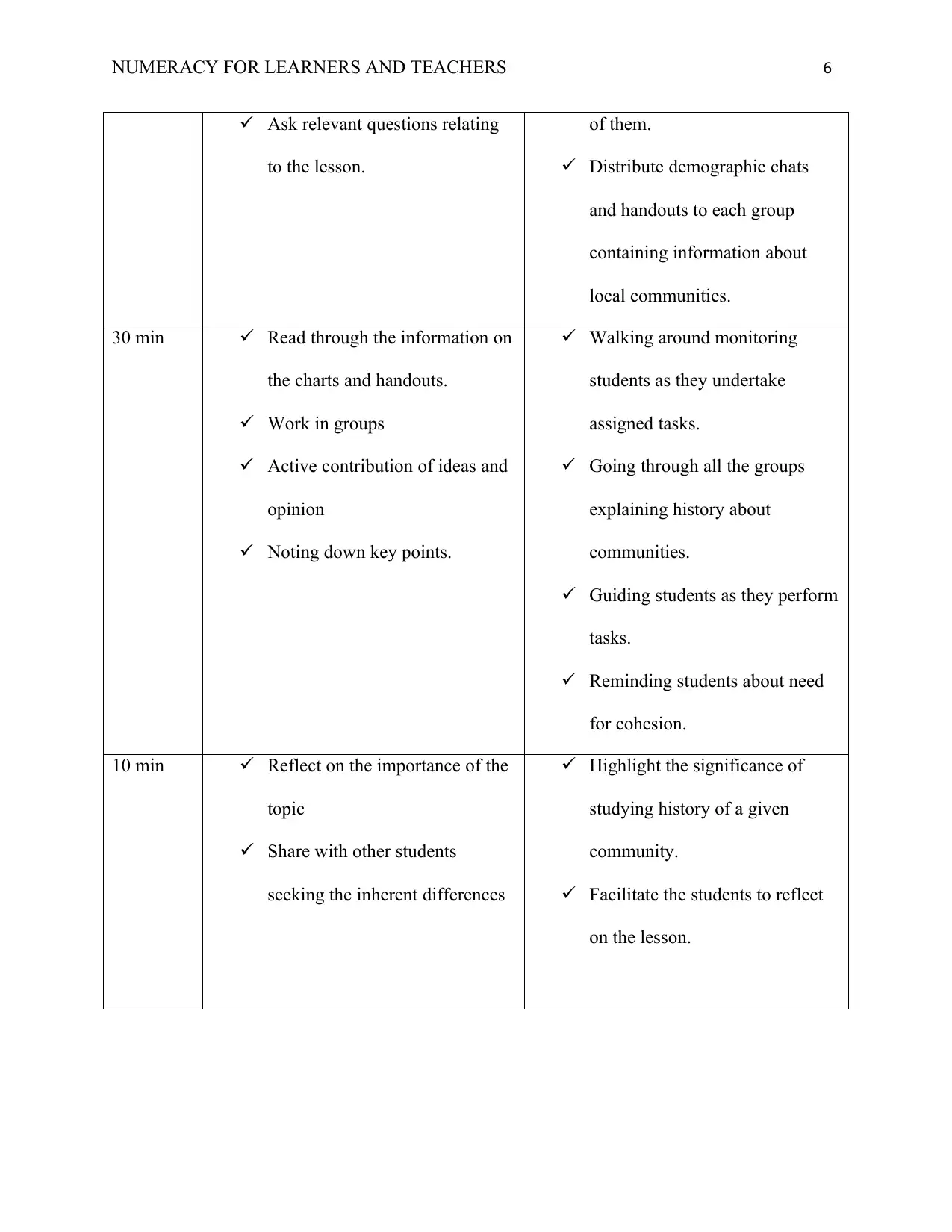
NUMERACY FOR LEARNERS AND TEACHERS 6
Ask relevant questions relating
to the lesson.
of them.
Distribute demographic chats
and handouts to each group
containing information about
local communities.
30 min Read through the information on
the charts and handouts.
Work in groups
Active contribution of ideas and
opinion
Noting down key points.
Walking around monitoring
students as they undertake
assigned tasks.
Going through all the groups
explaining history about
communities.
Guiding students as they perform
tasks.
Reminding students about need
for cohesion.
10 min Reflect on the importance of the
topic
Share with other students
seeking the inherent differences
Highlight the significance of
studying history of a given
community.
Facilitate the students to reflect
on the lesson.
Ask relevant questions relating
to the lesson.
of them.
Distribute demographic chats
and handouts to each group
containing information about
local communities.
30 min Read through the information on
the charts and handouts.
Work in groups
Active contribution of ideas and
opinion
Noting down key points.
Walking around monitoring
students as they undertake
assigned tasks.
Going through all the groups
explaining history about
communities.
Guiding students as they perform
tasks.
Reminding students about need
for cohesion.
10 min Reflect on the importance of the
topic
Share with other students
seeking the inherent differences
Highlight the significance of
studying history of a given
community.
Facilitate the students to reflect
on the lesson.
⊘ This is a preview!⊘
Do you want full access?
Subscribe today to unlock all pages.

Trusted by 1+ million students worldwide

NUMERACY FOR LEARNERS AND TEACHERS 7
Links to the 21st Century Numeracy Model (Goos, Giger, & Dole, 2014
The application of statistics and probability for estimation of the population creates a modern
context for students especially for the study of population. Through the application of statistical
tools, students are given the opportunity to design, interpret, and analyze measures of central
tendency such as mean, median, and mode. The lesson is, therefore, vital for the analysis of
statistical data. The nature of class activity will enable students to acquire a modern
understanding of population density and appropriate representation on population distribution
through graphs, charts, pictograms among others. Furthermore, the activity present students with
the opportunity to make use of graphical solutions like bar graphs, pie chart, and histograms in
describing population trends (Goos, Giger, & Dole, 2014).
Links to the 21st Century Numeracy Model (Goos, Giger, & Dole, 2014
The application of statistics and probability for estimation of the population creates a modern
context for students especially for the study of population. Through the application of statistical
tools, students are given the opportunity to design, interpret, and analyze measures of central
tendency such as mean, median, and mode. The lesson is, therefore, vital for the analysis of
statistical data. The nature of class activity will enable students to acquire a modern
understanding of population density and appropriate representation on population distribution
through graphs, charts, pictograms among others. Furthermore, the activity present students with
the opportunity to make use of graphical solutions like bar graphs, pie chart, and histograms in
describing population trends (Goos, Giger, & Dole, 2014).
Paraphrase This Document
Need a fresh take? Get an instant paraphrase of this document with our AI Paraphraser
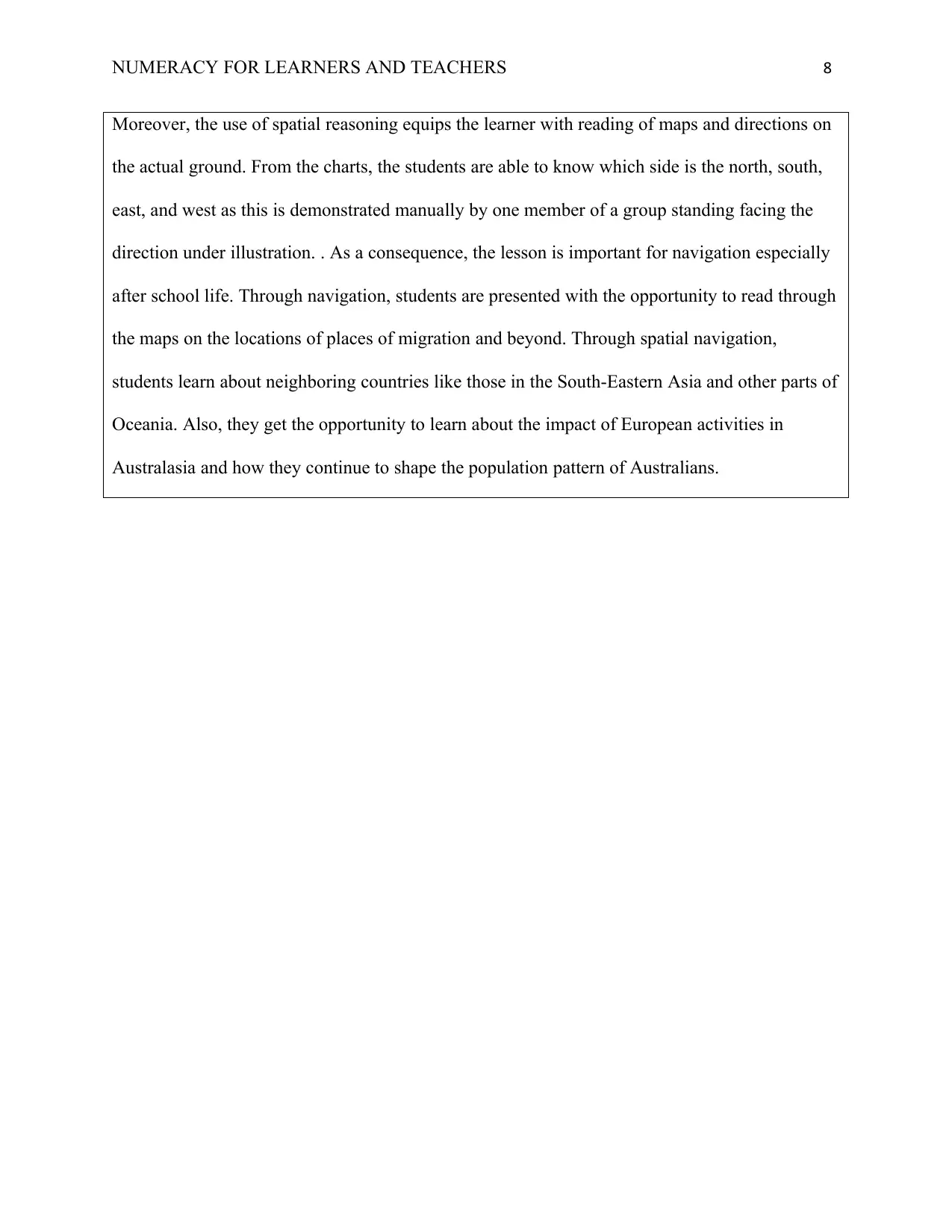
NUMERACY FOR LEARNERS AND TEACHERS 8
Moreover, the use of spatial reasoning equips the learner with reading of maps and directions on
the actual ground. From the charts, the students are able to know which side is the north, south,
east, and west as this is demonstrated manually by one member of a group standing facing the
direction under illustration. . As a consequence, the lesson is important for navigation especially
after school life. Through navigation, students are presented with the opportunity to read through
the maps on the locations of places of migration and beyond. Through spatial navigation,
students learn about neighboring countries like those in the South-Eastern Asia and other parts of
Oceania. Also, they get the opportunity to learn about the impact of European activities in
Australasia and how they continue to shape the population pattern of Australians.
Moreover, the use of spatial reasoning equips the learner with reading of maps and directions on
the actual ground. From the charts, the students are able to know which side is the north, south,
east, and west as this is demonstrated manually by one member of a group standing facing the
direction under illustration. . As a consequence, the lesson is important for navigation especially
after school life. Through navigation, students are presented with the opportunity to read through
the maps on the locations of places of migration and beyond. Through spatial navigation,
students learn about neighboring countries like those in the South-Eastern Asia and other parts of
Oceania. Also, they get the opportunity to learn about the impact of European activities in
Australasia and how they continue to shape the population pattern of Australians.
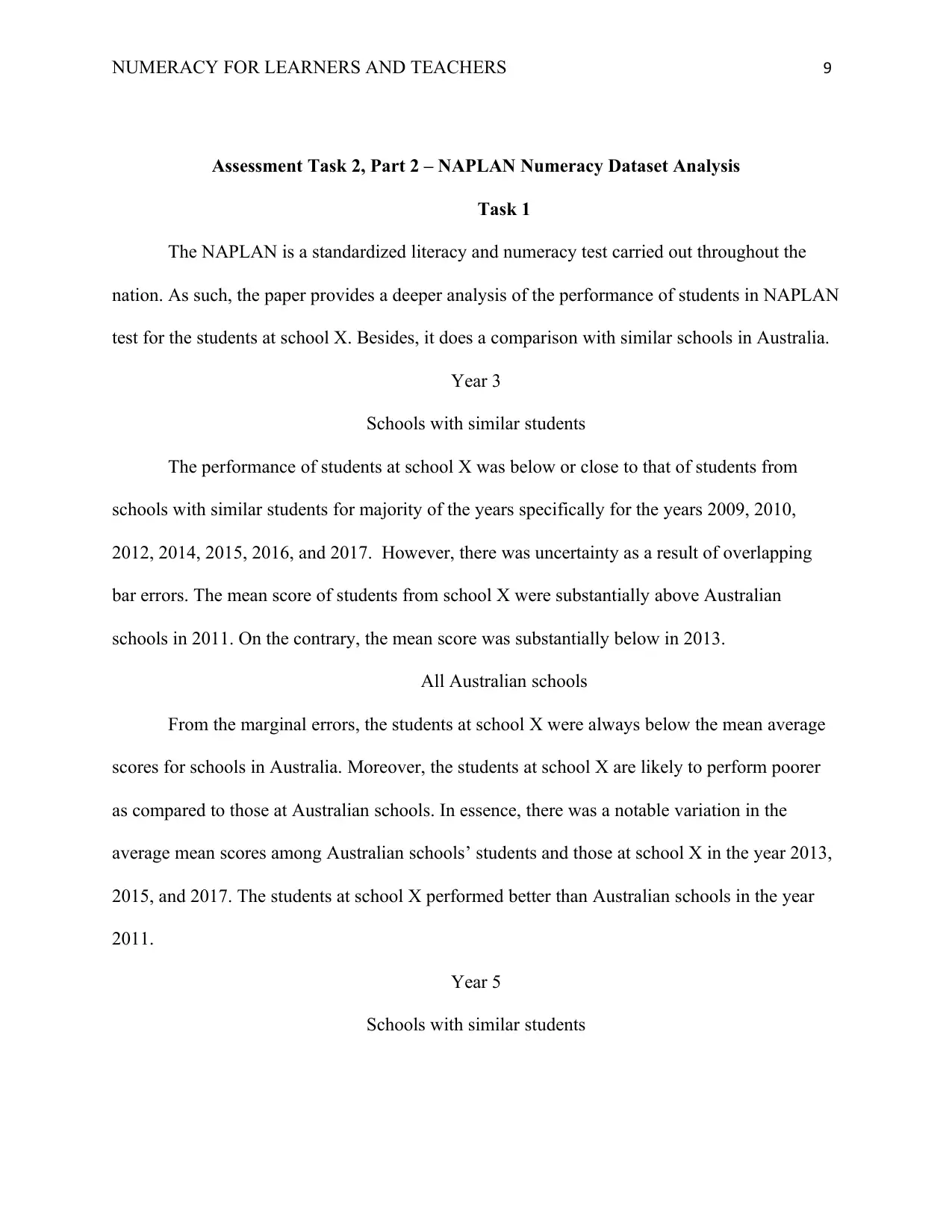
NUMERACY FOR LEARNERS AND TEACHERS 9
Assessment Task 2, Part 2 – NAPLAN Numeracy Dataset Analysis
Task 1
The NAPLAN is a standardized literacy and numeracy test carried out throughout the
nation. As such, the paper provides a deeper analysis of the performance of students in NAPLAN
test for the students at school X. Besides, it does a comparison with similar schools in Australia.
Year 3
Schools with similar students
The performance of students at school X was below or close to that of students from
schools with similar students for majority of the years specifically for the years 2009, 2010,
2012, 2014, 2015, 2016, and 2017. However, there was uncertainty as a result of overlapping
bar errors. The mean score of students from school X were substantially above Australian
schools in 2011. On the contrary, the mean score was substantially below in 2013.
All Australian schools
From the marginal errors, the students at school X were always below the mean average
scores for schools in Australia. Moreover, the students at school X are likely to perform poorer
as compared to those at Australian schools. In essence, there was a notable variation in the
average mean scores among Australian schools’ students and those at school X in the year 2013,
2015, and 2017. The students at school X performed better than Australian schools in the year
2011.
Year 5
Schools with similar students
Assessment Task 2, Part 2 – NAPLAN Numeracy Dataset Analysis
Task 1
The NAPLAN is a standardized literacy and numeracy test carried out throughout the
nation. As such, the paper provides a deeper analysis of the performance of students in NAPLAN
test for the students at school X. Besides, it does a comparison with similar schools in Australia.
Year 3
Schools with similar students
The performance of students at school X was below or close to that of students from
schools with similar students for majority of the years specifically for the years 2009, 2010,
2012, 2014, 2015, 2016, and 2017. However, there was uncertainty as a result of overlapping
bar errors. The mean score of students from school X were substantially above Australian
schools in 2011. On the contrary, the mean score was substantially below in 2013.
All Australian schools
From the marginal errors, the students at school X were always below the mean average
scores for schools in Australia. Moreover, the students at school X are likely to perform poorer
as compared to those at Australian schools. In essence, there was a notable variation in the
average mean scores among Australian schools’ students and those at school X in the year 2013,
2015, and 2017. The students at school X performed better than Australian schools in the year
2011.
Year 5
Schools with similar students
⊘ This is a preview!⊘
Do you want full access?
Subscribe today to unlock all pages.

Trusted by 1+ million students worldwide
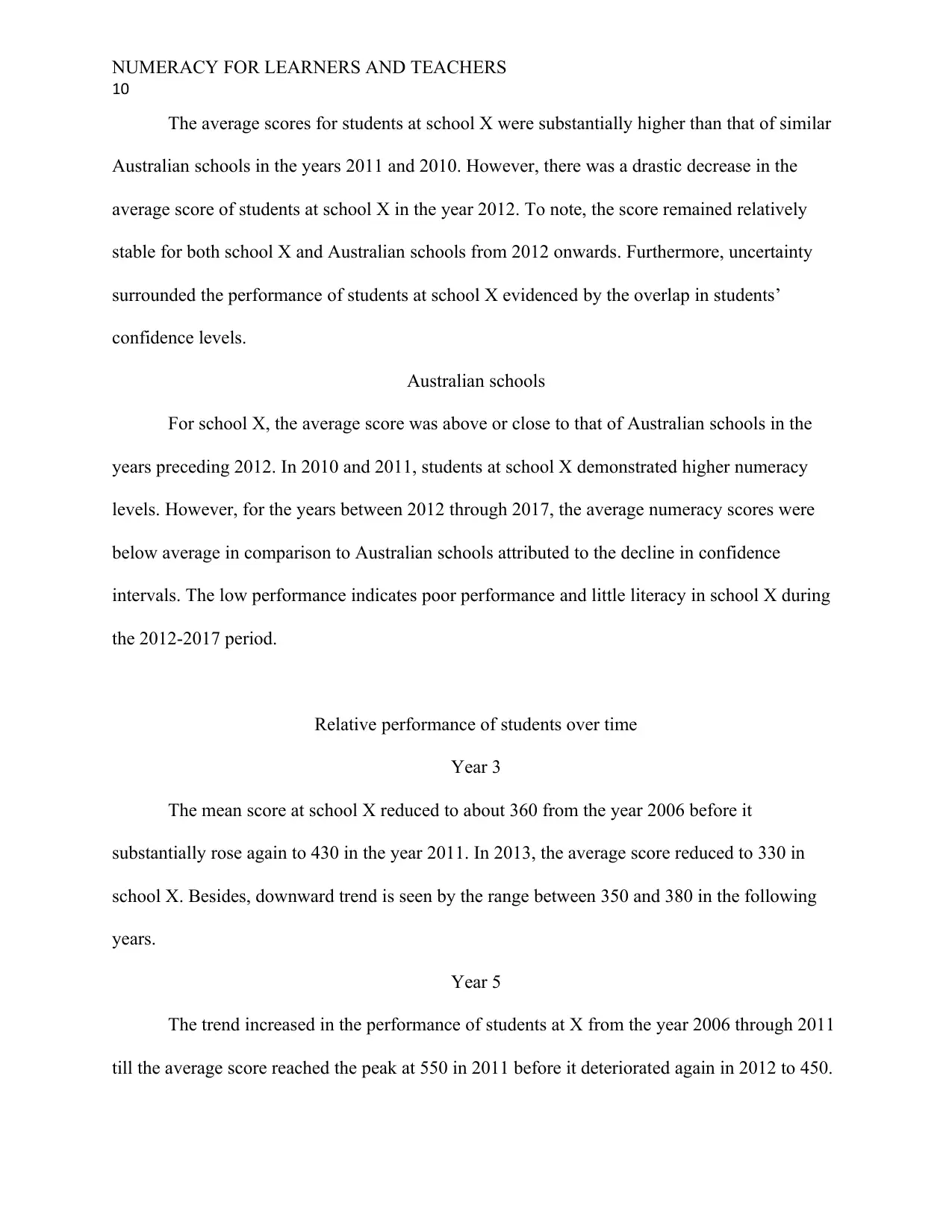
NUMERACY FOR LEARNERS AND TEACHERS
10
The average scores for students at school X were substantially higher than that of similar
Australian schools in the years 2011 and 2010. However, there was a drastic decrease in the
average score of students at school X in the year 2012. To note, the score remained relatively
stable for both school X and Australian schools from 2012 onwards. Furthermore, uncertainty
surrounded the performance of students at school X evidenced by the overlap in students’
confidence levels.
Australian schools
For school X, the average score was above or close to that of Australian schools in the
years preceding 2012. In 2010 and 2011, students at school X demonstrated higher numeracy
levels. However, for the years between 2012 through 2017, the average numeracy scores were
below average in comparison to Australian schools attributed to the decline in confidence
intervals. The low performance indicates poor performance and little literacy in school X during
the 2012-2017 period.
Relative performance of students over time
Year 3
The mean score at school X reduced to about 360 from the year 2006 before it
substantially rose again to 430 in the year 2011. In 2013, the average score reduced to 330 in
school X. Besides, downward trend is seen by the range between 350 and 380 in the following
years.
Year 5
The trend increased in the performance of students at X from the year 2006 through 2011
till the average score reached the peak at 550 in 2011 before it deteriorated again in 2012 to 450.
10
The average scores for students at school X were substantially higher than that of similar
Australian schools in the years 2011 and 2010. However, there was a drastic decrease in the
average score of students at school X in the year 2012. To note, the score remained relatively
stable for both school X and Australian schools from 2012 onwards. Furthermore, uncertainty
surrounded the performance of students at school X evidenced by the overlap in students’
confidence levels.
Australian schools
For school X, the average score was above or close to that of Australian schools in the
years preceding 2012. In 2010 and 2011, students at school X demonstrated higher numeracy
levels. However, for the years between 2012 through 2017, the average numeracy scores were
below average in comparison to Australian schools attributed to the decline in confidence
intervals. The low performance indicates poor performance and little literacy in school X during
the 2012-2017 period.
Relative performance of students over time
Year 3
The mean score at school X reduced to about 360 from the year 2006 before it
substantially rose again to 430 in the year 2011. In 2013, the average score reduced to 330 in
school X. Besides, downward trend is seen by the range between 350 and 380 in the following
years.
Year 5
The trend increased in the performance of students at X from the year 2006 through 2011
till the average score reached the peak at 550 in 2011 before it deteriorated again in 2012 to 450.
Paraphrase This Document
Need a fresh take? Get an instant paraphrase of this document with our AI Paraphraser
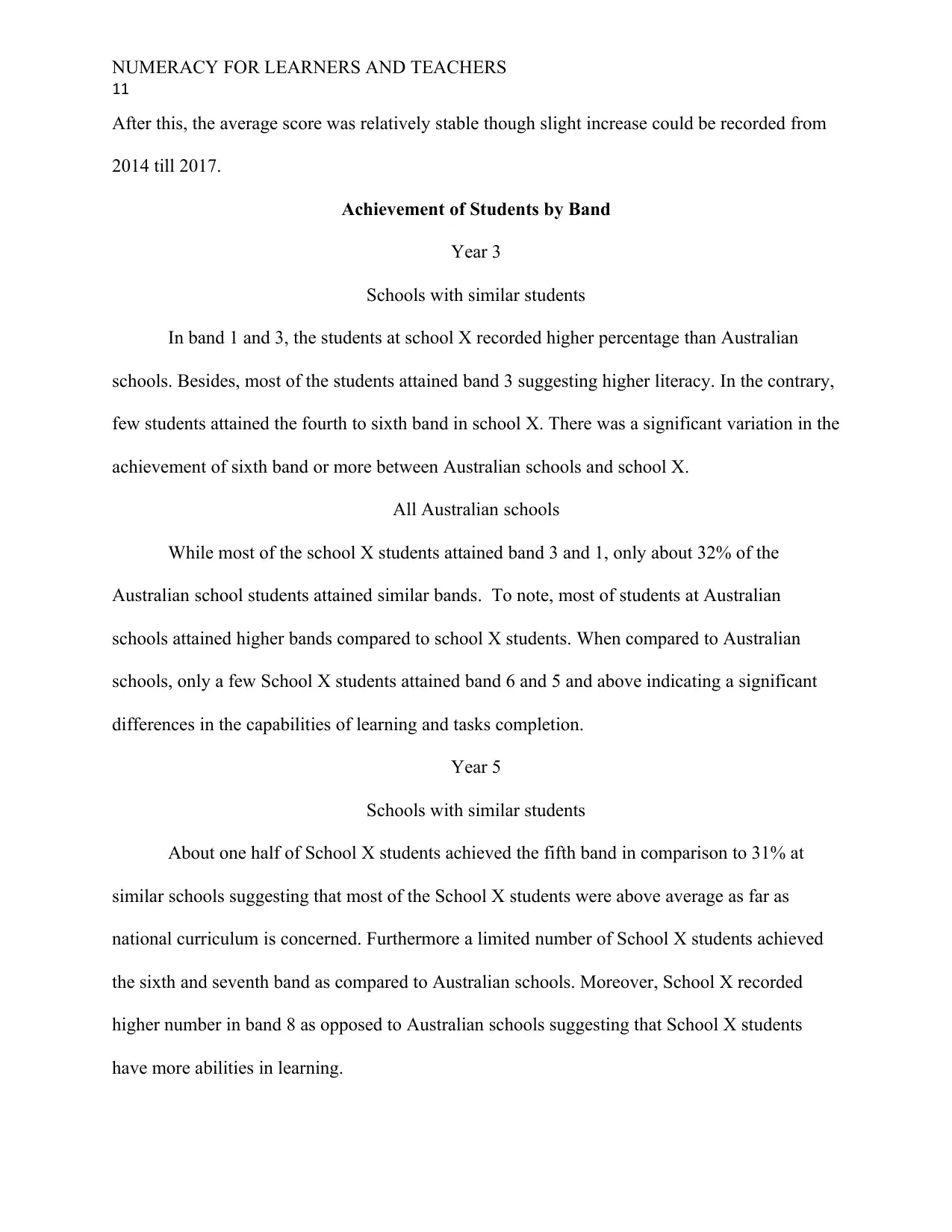
NUMERACY FOR LEARNERS AND TEACHERS
11
After this, the average score was relatively stable though slight increase could be recorded from
2014 till 2017.
Achievement of Students by Band
Year 3
Schools with similar students
In band 1 and 3, the students at school X recorded higher percentage than Australian
schools. Besides, most of the students attained band 3 suggesting higher literacy. In the contrary,
few students attained the fourth to sixth band in school X. There was a significant variation in the
achievement of sixth band or more between Australian schools and school X.
All Australian schools
While most of the school X students attained band 3 and 1, only about 32% of the
Australian school students attained similar bands. To note, most of students at Australian
schools attained higher bands compared to school X students. When compared to Australian
schools, only a few School X students attained band 6 and 5 and above indicating a significant
differences in the capabilities of learning and tasks completion.
Year 5
Schools with similar students
About one half of School X students achieved the fifth band in comparison to 31% at
similar schools suggesting that most of the School X students were above average as far as
national curriculum is concerned. Furthermore a limited number of School X students achieved
the sixth and seventh band as compared to Australian schools. Moreover, School X recorded
higher number in band 8 as opposed to Australian schools suggesting that School X students
have more abilities in learning.
11
After this, the average score was relatively stable though slight increase could be recorded from
2014 till 2017.
Achievement of Students by Band
Year 3
Schools with similar students
In band 1 and 3, the students at school X recorded higher percentage than Australian
schools. Besides, most of the students attained band 3 suggesting higher literacy. In the contrary,
few students attained the fourth to sixth band in school X. There was a significant variation in the
achievement of sixth band or more between Australian schools and school X.
All Australian schools
While most of the school X students attained band 3 and 1, only about 32% of the
Australian school students attained similar bands. To note, most of students at Australian
schools attained higher bands compared to school X students. When compared to Australian
schools, only a few School X students attained band 6 and 5 and above indicating a significant
differences in the capabilities of learning and tasks completion.
Year 5
Schools with similar students
About one half of School X students achieved the fifth band in comparison to 31% at
similar schools suggesting that most of the School X students were above average as far as
national curriculum is concerned. Furthermore a limited number of School X students achieved
the sixth and seventh band as compared to Australian schools. Moreover, School X recorded
higher number in band 8 as opposed to Australian schools suggesting that School X students
have more abilities in learning.
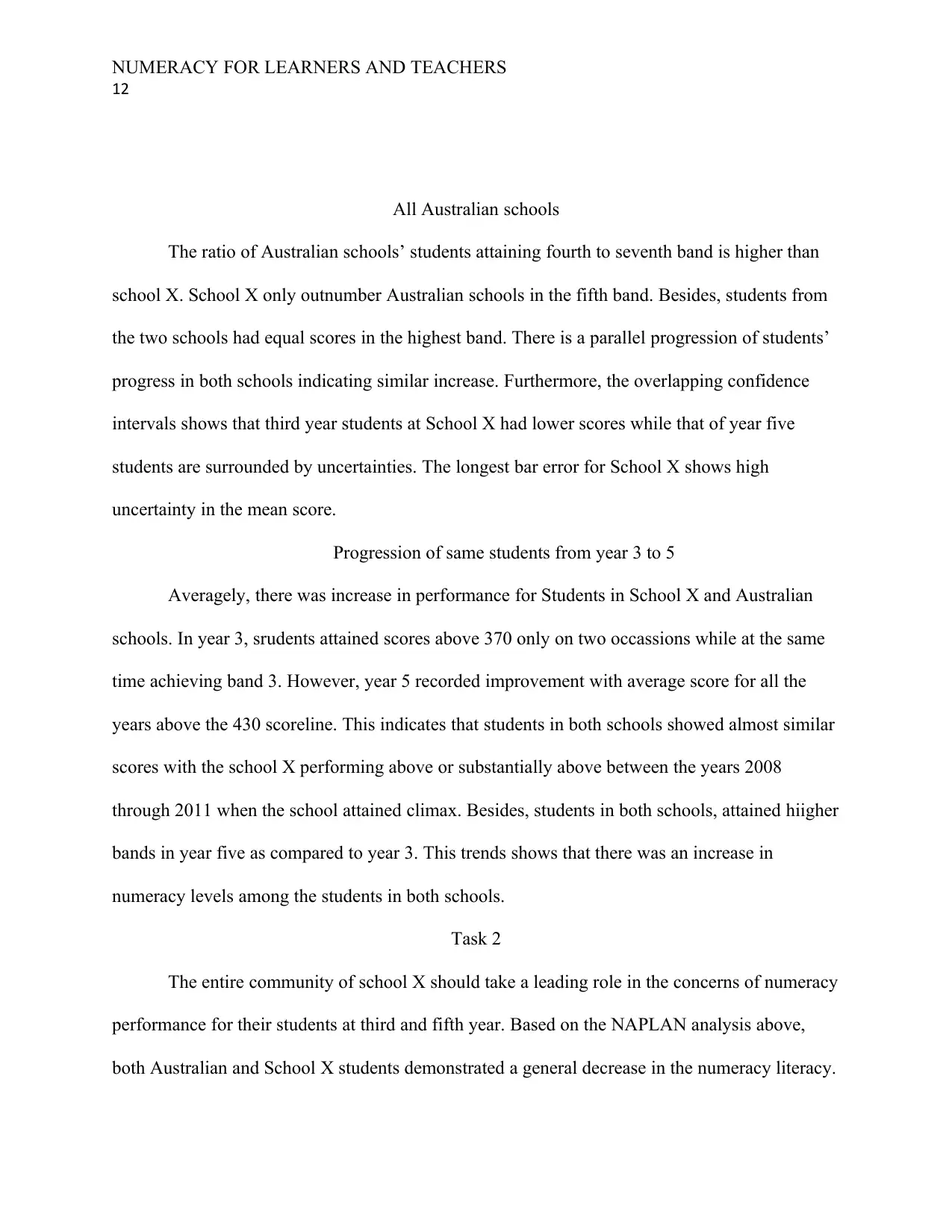
NUMERACY FOR LEARNERS AND TEACHERS
12
All Australian schools
The ratio of Australian schools’ students attaining fourth to seventh band is higher than
school X. School X only outnumber Australian schools in the fifth band. Besides, students from
the two schools had equal scores in the highest band. There is a parallel progression of students’
progress in both schools indicating similar increase. Furthermore, the overlapping confidence
intervals shows that third year students at School X had lower scores while that of year five
students are surrounded by uncertainties. The longest bar error for School X shows high
uncertainty in the mean score.
Progression of same students from year 3 to 5
Averagely, there was increase in performance for Students in School X and Australian
schools. In year 3, srudents attained scores above 370 only on two occassions while at the same
time achieving band 3. However, year 5 recorded improvement with average score for all the
years above the 430 scoreline. This indicates that students in both schools showed almost similar
scores with the school X performing above or substantially above between the years 2008
through 2011 when the school attained climax. Besides, students in both schools, attained hiigher
bands in year five as compared to year 3. This trends shows that there was an increase in
numeracy levels among the students in both schools.
Task 2
The entire community of school X should take a leading role in the concerns of numeracy
performance for their students at third and fifth year. Based on the NAPLAN analysis above,
both Australian and School X students demonstrated a general decrease in the numeracy literacy.
12
All Australian schools
The ratio of Australian schools’ students attaining fourth to seventh band is higher than
school X. School X only outnumber Australian schools in the fifth band. Besides, students from
the two schools had equal scores in the highest band. There is a parallel progression of students’
progress in both schools indicating similar increase. Furthermore, the overlapping confidence
intervals shows that third year students at School X had lower scores while that of year five
students are surrounded by uncertainties. The longest bar error for School X shows high
uncertainty in the mean score.
Progression of same students from year 3 to 5
Averagely, there was increase in performance for Students in School X and Australian
schools. In year 3, srudents attained scores above 370 only on two occassions while at the same
time achieving band 3. However, year 5 recorded improvement with average score for all the
years above the 430 scoreline. This indicates that students in both schools showed almost similar
scores with the school X performing above or substantially above between the years 2008
through 2011 when the school attained climax. Besides, students in both schools, attained hiigher
bands in year five as compared to year 3. This trends shows that there was an increase in
numeracy levels among the students in both schools.
Task 2
The entire community of school X should take a leading role in the concerns of numeracy
performance for their students at third and fifth year. Based on the NAPLAN analysis above,
both Australian and School X students demonstrated a general decrease in the numeracy literacy.
⊘ This is a preview!⊘
Do you want full access?
Subscribe today to unlock all pages.

Trusted by 1+ million students worldwide
1 out of 19